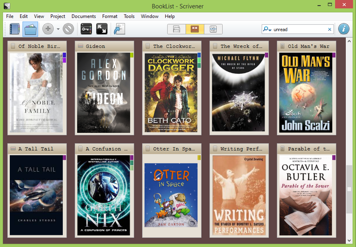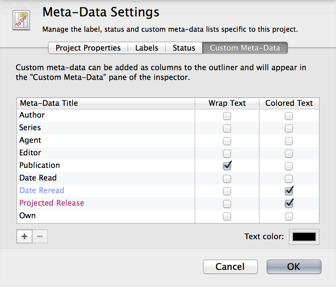Toward the end of last year, fed up with my failed attempts to keep track of books I'd read and books I wanted to read, I created a Scrivener project to manage my reading lists. It's proven so successful, I thought I'd show it off.
Keeping a Book List

Clicking the index-card icon in the inspector "Synopsis" header switches to image mode, allowing you to drag cover images onto the cards.
I renamed the Draft folder "Library" and gave it a fitting custom icon via Documents > Change Icon. Each book title goes into this as a new document, so the book can have unique meta-data and a synopsis (or synopsis image). Notes about the book, anything from a few thoughts after reading to a full review, go into the document text.
Although I tend toward filing systems, I've kept my Library as a flat list rather than pigeonhole entries into folders. Instead, I use keywords to mark a book's genre, which lets me tag it with multiple terms--a book might be "YA", "steampunk", and "mystery", for example--and then use project search to filter my list.
In the Project > Meta-Data Settings, I've repurposed the Label and Status settings to show the book's state--read, unread, or shelved--and my rating. I tint the icons in the binder with the label so each title's read state is immediately visible. I colour the index cards with the label as well.

Label is renamed "Status", with its colour shown throughout Scrivener via the View > Use Label Color In submenu. The default Status is renamed "Rating" and uses 1-5 stars, added from Edit > Special Characters on the Mac and Edit > Character Map on Windows.
Most other form information I enter as custom meta-data. Since I use dates in multiple fields, for first read, reread, potential release date, and publication date, I prefix the date, year-first, with a letter so I can search for a particular field. For example, I can assemble a list of all new books read in 2015 by searching meta-data for "r2015” or list all books total for the year by searching for both "r2015” and “re2015” (rereads).

Searches I run frequently I save as collections, via the magnifying-glass menu in the project search bar. It's quite gratifying to load my "read" list and see it growing over the year!
If you keep a reading list, what details do you record and how do you keep it organised?


4 Comments
JH / 24 APRIL 2015
Hi David - Thanks for the comment! I gave Goodreads a try for a while, but I fell off using it pretty quickly. Maybe it's different now, but at the time I couldn't make comments private to just a small group of friends, and the interface was a bit irritating. Overall I just decided I preferred to keep a private list rather than worry about burning author/editor/agent bridges with poor ratings or unthoughtful reviews that were meant as short comments to myself rather than a fleshed-out review. Scrivener's worked out great for this because I can just put in whatever details or comments I want without fear of backlash. Useful for keeping personal notes about potential gift recipients as well! :)
Oscar - Well, I did ask. :) My original draft actually mentioned my brief stint with Goodreads, but I have a tendency to be wordy for these, so I cut it. It's a completely valid point: there are services for this sort of thing, like Goodreads or Library Thing. I just found I preferred a private list and on giving Scrivener a try discovered it worked really well for everything I needed. It doesn't hurt that I more or less live in Scrivener, so popping open the project to add new titles is far easier for me than fighting the internet, remembering my sign-in, and fussing through which edition of a book I want to add. If the social aspect mattered to me, though, I might have struggled longer with it. As it is, most of my book discussions are in less public arenas.
JH / 29 APRIL 2015
LN - Glad the post inspired you! I hadn't thought of it as a way to learn Scrivener--in a way, keeping a reading list might be a bit antithetical to the purpose of <em>writing software</em>, unless you're much better than I am about writing reviews and notes about your reading! But since you said that, I considered that it could be a way of learning useful features like project search and labels without the complication of trying to simultaneously apply them to your own work. Handling each book as its own document and seeing how that gives you more freedom with the meta-data might also help get you into the Scrivener mindset of writing in chunks, rather than dumping all your text in a single document.
Thanks for bringing up the idea! I've been jotting notes about teaching Scrivener, and your comment has got me thinking along new lines. I appreciate it!
JH / 29 APRIL 2015
Scott - Is there a way to keep personal lists on the Kindle app of "read", "want to read", etc., or do you mean that the Kindle essentially houses your library (including borrowed books), so it's a way to scroll through your reading history? I have become fond of my Kindle for its insta-library-book magic, but I've purchased very few digital books and still read plenty of paper, so a Kindle-only list wouldn't help me much.
Part of what I appreciate about using Scrivener for this, somewhat ironically, is that it <em>isn't</em> a dedicated "book list" program. Maybe it's just that I'm comfortable with Scrivener, but I never feel bullied into filling out meta-data or needing to rate a book I just finished (and I don't feel guilty about changing a rating later after I've thought about it more). Plus I can track other interesting data, like a book's editor or agent. If you haven't tried it, agent-stalking can be quite fun and lucrative for your reading list. :) I've added a lot of authors to my list that way.
JH / 11 MAY 2015
Scott - I've never seen my wishlist from the Kindle, but maybe that's a wifi/4G sort of difference. At any rate, my list is too messy to be much use. There is that "manage your device" page that has been useful in checking dates and details on books I've read. (In fact I probably should go take a look and check it against my Scrivener list; maybe there will be some things to add. When I started the project I didn't bother adding previous books, with just a few exceptions to get me started, but more recent books or ones I might particularly want to remember would be worth adding.) As far as paper vs. digital...well, I won't have that debate. ;) I still do love real paper, but there is certainly convenience in digital versions for multiple reasons. I <em>am</em> rather low on semi-flat surfaces whereon to store physical books.
cantus - Evernote! I hadn't thought of that one, not being an Evernote user, but it's one of those "store everything, access anywhere" tools that I can see being handy for this. I assume you just tag each entry with whatever data you want (similar to how I use keywords and custom meta-data in Scrivener)? I like the idea of exporting the margin notes straight to your book list, so I'll have to consider how to do that. I don't often make notes with the Kindle (most of my digital book reading) but I know it's doable, having tried Kindle for editing. I suppose really I just don't make enough notes on my reading. ;) Most of what I read on the Kindle is fiction and squeezed into spare moments (or replacing sleep, but I really should break that habit) so I don't break for notes in the moment, but PDFs and such...hm. Anyway it would be an interesting exercise. I sync annotated PDF drafts back into my writing project (where I want everything in context), but I've never tried pulling just notes.
Kyle - Thanks! I've really been enjoying keeping my reading list this way--just <em>keeping</em> the list has been rewarding. (I have been known to make lists just so I can check off items I've already done, so watching a "books read" list grow over the year is remarkably satisfying. And I'm finally able to go back and find those random books I saw mentioned and wanted to check out!) To adjust the ratio of the cards, click the icon of the four rectangles (cards) in the right of the corkboard footer. (The footer isn't visible in my screenshot; you toggle it on and off via View > Layout > Show/Hide Footer View.) From there you can change the size, ratio, spacing, etc. of the cards, so I set something that fit the majority of my covers, I think 8x5.
Please sign in or register to comment on this post.
Register
Sign in
Forgotten password